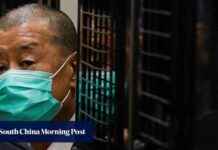Hong Kong leader John Lee has voiced his concerns about the recent deaths of monkeys at a zoo in the city, stating that the issue needs to be contained following the ninth death and monitoring of a tenth animal’s health. The government released a statement revealing the death of another white-faced saki at the Hong Kong Zoological and Botanical Gardens, along with the deaths of eight other monkeys, including critically endangered cotton-top tamarins. The situation prompted an interdepartmental meeting led by Secretary for Culture, Sports and Tourism Kevin Yeung to address the issue.
During a press conference, Chief Executive Lee emphasized the importance of containing the problem and closely monitoring the health of the animals in the zoo. He mentioned that the enclosures have been closed for disinfection and staff are required to wear protective gear while cleaning or monitoring the area. Necropsies and toxicological testing have been conducted on the monkeys to determine the cause of death, with results expected soon to allow for targeted action.
Reports suggest that experts believe the deaths may be due to collective poisoning rather than infection, which would explain the sudden deaths of the monkeys. The zoo’s mammal section has been closed for cleansing and disinfection, with all other animals showing normal health conditions. The zoo houses a variety of animals, including monkeys, tamarins, apes, lemurs, meerkats, and otters.
The Hong Kong Zoological and Botanical Gardens are home to a diverse range of species, with about 158 birds, 93 mammals, and 21 reptiles residing in 40 enclosures. While cotton-top tamarins are critically endangered, De Brazza’s monkeys, common squirrel monkeys, and white-faced sakis are considered of least concern according to the International Union for Conservation of Nature’s Red List.
As investigations continue and measures are taken to address the situation, the government has assured the public that prompt announcements will be made regarding the latest developments. The health and safety of the animals and staff remain a top priority as authorities work to ensure the well-being of the zoo’s inhabitants.



















